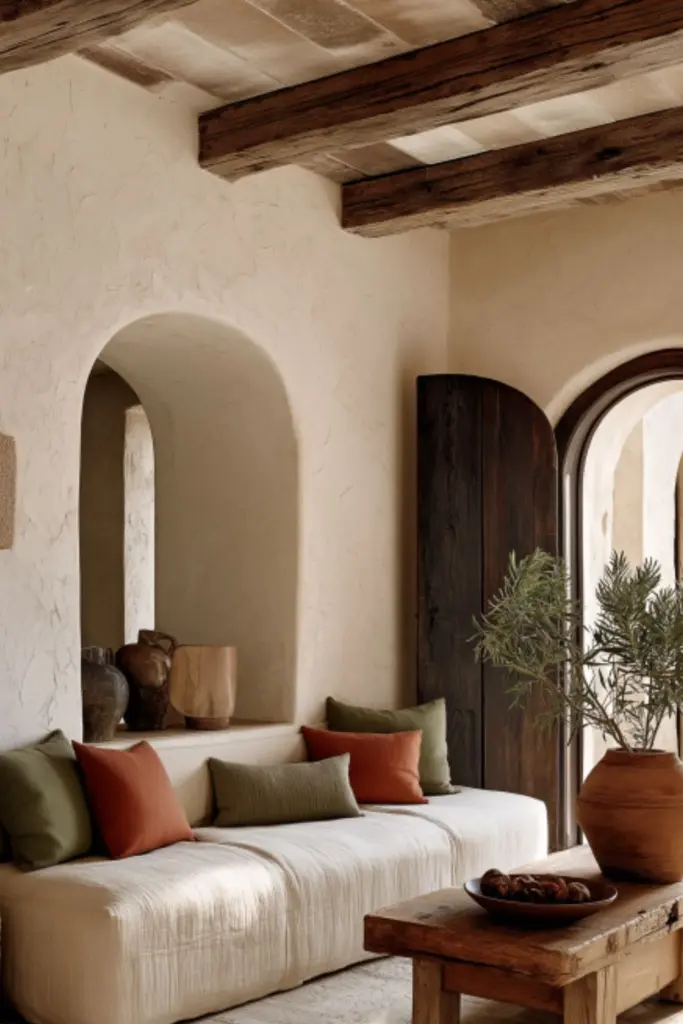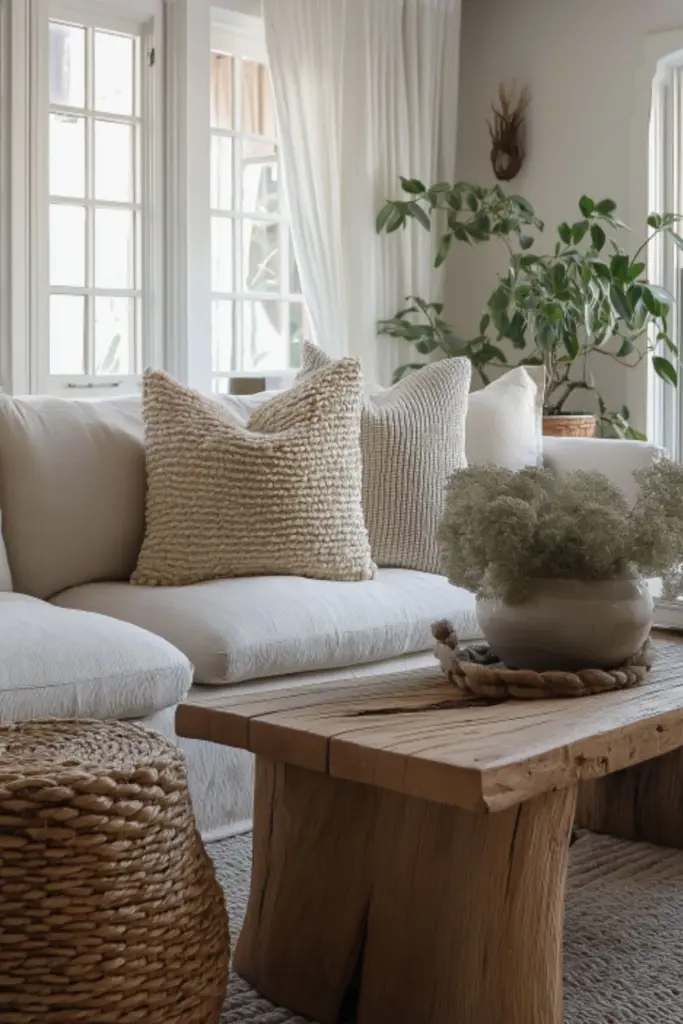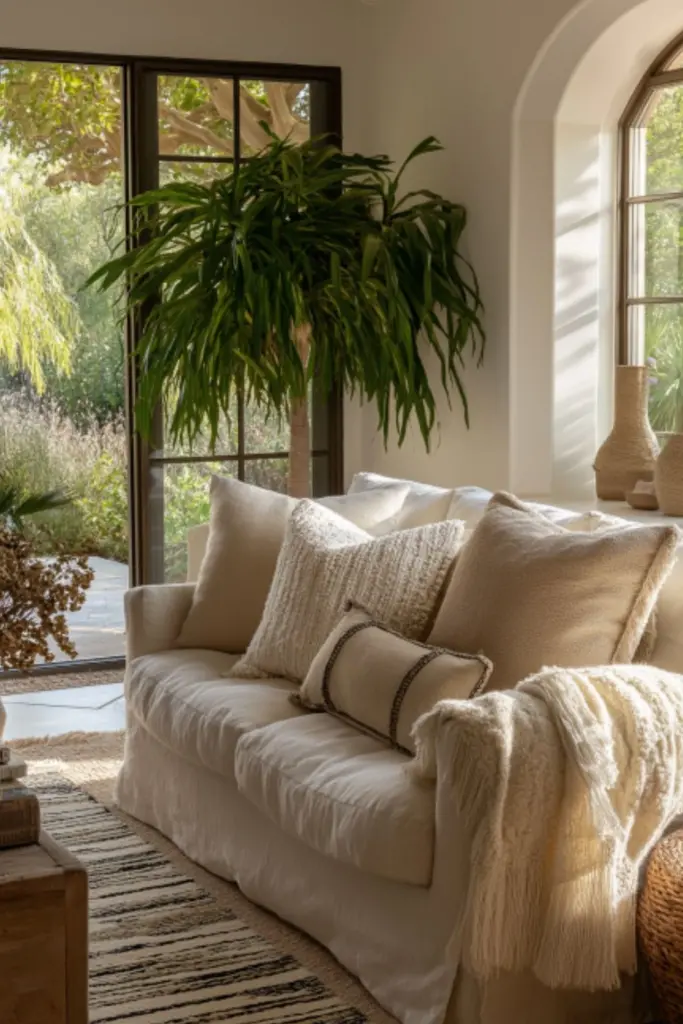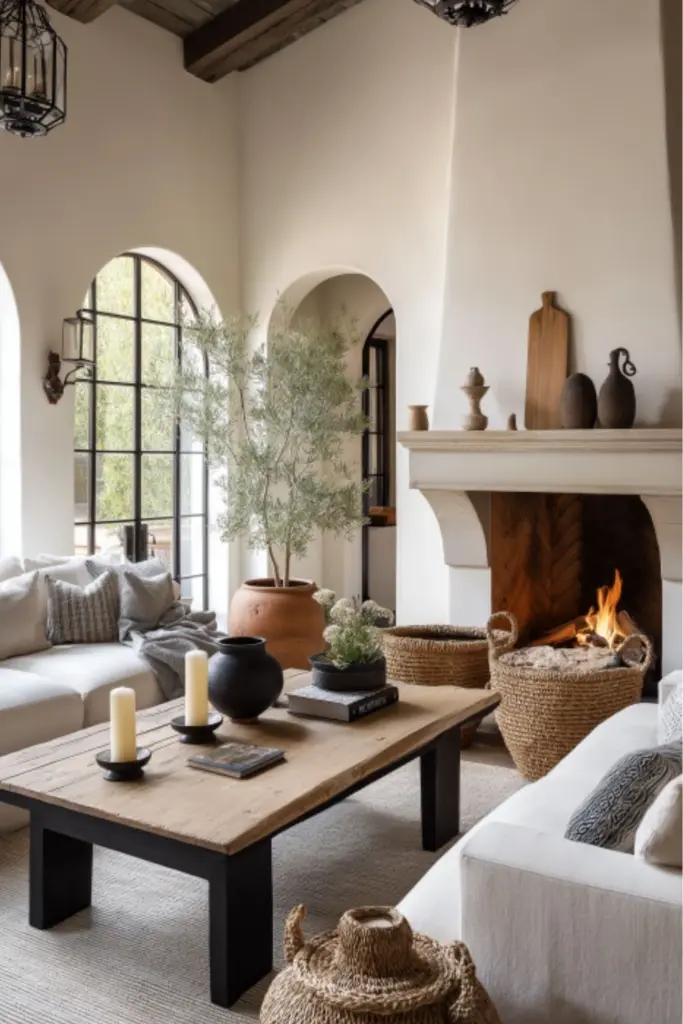Mediterranean Living Room Ideas with Natural Materials for Timeless Charm
Table of Contents
What if your living room could feel like a sunlit coastal villa in the Mediterranean, right in your own home? According to real estate design trends, homeowners increasingly favor decor that blends nature with curated comfort—and Mediterranean style is prized for doing exactly that. By infusing your living room with natural materials like stone, wood, plaster, and woven elements, you can create a space that’s both timeless and evocative of sun-drenched shores.
This isn’t about flashy, thematic décor—it’s about soulful layers, tactile surfaces, and a gentle sense of history. These Mediterranean living room ideas with natural materials bring warmth, texture, and serene beauty without feeling elaborate or fussy. You’ll learn how to seamlessly incorporate exposed beams and stonework, choose furniture that mirrors coastal simplicity, layer earthy textiles, and curate ornamental accents with meaning.
In the sections to follow, we’ll unravel the essentials: from choosing materials and balancing color palettes to planning textures, selecting artisanal furnishings, integrating greenery, lighting for ambiance, and creating harmonious layout. If you’re seeking a design that will stand the test of time—not just trend—this guide is your blueprint.
Embracing Natural Materials for Authentic Mediterranean Style

Mediterranean interiors rely on authentic, natural elements to create a sense of place. Think exposed wood, stone walls or fireplaces, plastered surfaces, and woven accents. These materials are not just aesthetic; they tell a story of craftsmanship and connection to the earth.
Rustic ceiling beams—perhaps olive or pine—immediately establish a grounded, structural warmth. Stone features, whether a fireplace surround or cladding a hearth wall, call to mind ancient villas built to last. Earthen plaster walls in soft cream or light ochre replace crisp drywall finishes with a tactile, lived-in patina.
Woven materials—rattan chairs, wicker baskets, seagrass rugs—introduce natural lines and pattern while keeping the palette sunlit and soft. The secret is balance: combine a rustic stone wall with smooth, polished floors; place rough-hewn wood side tables beside curved plaster columns; and blend cool stone with warm woods in furniture.
Material Palette Overview
| Material | Visual Qualities | Typical Use |
|---|---|---|
| Exposed wood beams | Warmth, structure, history | Ceilings, mantels, furniture accents |
| Natural stone | Weight, texture, permanence | Walls, fireplaces, flooring accents |
| Earthen plaster | Soft texture, subtle color shifts | Walls, alcoves, built-ins |
| Woven rattan or seagrass | Organic pattern, casual feel | Rugs, seating, baskets |
Color Palette: Soft Sun-Kissed Neutrals and Earthy Accents

The Mediterranean palette is rooted in sun-bleached terracotta, dove gray, warm sand, and soft white. These neutrals evoke beach villages and centuries-old courtyards, yet feel modern and fresh.
Base walls in a creamy plaster invite light reflection and warmth. Floors in honey-toned stone, terracotta tile, or natural wood tie into the earth’s palette. Accent colors—olive green, muted navy, clay red—are best used sparingly, as intentional cushions, throws, or art pieces.
Contrast in Mediterranean rooms isn’t bold—it’s subtle. A charcoal gray stone hearth against a light plaster wall, or an aged olive-wood coffee table resting on a sandy seagrass rug—these soft oppositions create harmony and comfort, not flash.
Palette Coordination Guide
| Palette Element | Color Range | Coordinated Use |
|---|---|---|
| Walls | Cream, pearl, soft beige | Background for furniture and art |
| Flooring | Terracotta, stone gray, light oak | Anchor the room’s tone |
| Accent touches | Olive green, clay, navy | Pillows, art, plant pots |
| Metal finishes | Aged bronze, matte black, brass | Lighting, hardware, frames |
Curated Furniture That Reflects Simplicity and Comfort

Mediterranean style is about comfort, not opulence. Furniture should be relaxed, hand-crafted, and layered with softness. Think overstuffed linen sofas, reclaimed wood coffee tables, and iron or black metal accents that echo artisanal realism.
A neutral sofa with removable linen covers offers both long-term wearability and relaxed elegance. Pair it with wood side chairs with cotton cushions, or woven stools that feel coastal. Round or oval tables soften lines and mirror the organic textures around them.
Balance dense furniture with airy elements—open frame shelving, glass-topped occasional tables, and slim metal frames. It ensures the room remains bright and breezy. Choose materials and silhouettes that favor craftsmanship over precision, such as imperfect planks, visible wood grain, and curved lines.
Furniture Selection Tips
| Piece | Suggested Material and Style | Why It Works in Mediterranean Design |
|---|---|---|
| Sofa | White linen, removable covers | Clean base to build softness |
| Coffee table | Reclaimed olive or pine wood | Earthy focal with narrative quality |
| Accent chairs | Iron or black frame w/ linen seat | Adds architectural contrast |
| Ottoman or stool | Rattan, seagrass, or wool cushion | Layered texture and flexible seating |
Layering Textiles: Rugs, Throws, and Pillow Storytelling

Textiles bring atmosphere, comfort, and visual depth to a natural-material Mediterranean living room. The key is to layer lightly, allowing each element to shine.
Start with a seagrass or jute rug in a living area—it provides structure without competing with natural tones. Overlaid, add smaller-patterned wool kilims or flatweaves in muted terracotta, olive, or creamy linens to define seating zones.
Throws and pillows should echo natural fibers—cotton, linen, wool. Appliqué embroidery, simple stripes, or woven texture add character without clutter. One or two bold pillows in clay red or burnt orange can punctuate the neutral base without overwhelming it.
Draped blankets in a woven basket enhance comfort and tie in dried botanical elements like lavender or olive branches. This is where simplicity becomes soulful.
Textile Layering Guide
| Layer | Material and Design | Function and Effect |
|---|---|---|
| Base rug | Seagrass or jute | Earthy foundation, neutral and sturdy |
| Accent rug | Wool kilim, flatweave, muted pattern | Defines area, adds soft color |
| Cushions | Linen, wool, subtle patterns | Comfort, visual interest |
| Throws | Cotton or woven wool | Warmth, drape, rustic charm |
Artisanal Accents and Decorative Details
What makes a Mediterranean living room feel lived‑in and unique are the small, artisan touches that echo local craftsmanship. Decorative accents shouldn’t be trendy but curated—to give a sense of place and purpose.
Woven baskets, ceramic jugs, terra-cotta pots, and handmade glass bottles (like Spanish botellas) act as both decor and utility. Place pottery on shelves or in groupings near natural light, where shadows and texture can play.
Hand-forged metal candleholders, blackened iron sconces, or olive wood chopping boards stacked by a hearth bring warmth and authenticity. A vintage canvas rug or tapestry, perhaps inherited or sourced from travels, acts as a storytelling focal point.
Grouping items by color family or material—like a trio of alabaster bowls—helps maintain a visual calm. Less is more; each piece should earn its place.
Artisan Accent Checklist
| Accent Type | Recommended Material/Style | Layout Suggestion |
|---|---|---|
| Woven baskets | Seagrass or wheat | Nested near sofa or plant corner |
| Pottery vases | Terracotta, glazed, handmade | Cluster for visual balance |
| Metal elements | Forged iron candleholders | Bracket shelves or coffee tables |
| Glass bottles | Colored recycled glass | Grouped on a windowsill or console |
| Textile art | Kilim wall hanging or tapestry | Centered above mantel or sofa |
Incorporating Lush Greenery for Freshness and Texture
No Mediterranean room is complete without greenery. Olive trees, fiddle-leaf figs, eucalyptus, or fragrant herbs bring life into the room and echo the region’s flora.
Large potted trees in rustic clay or stone pots near a window become living sculptures. Medium plants like rosemary or lavandin in terracotta vessels bring scent and soft green tones close to seating areas. Low pots with succulents or trailing ivy add softness to tabletops.
Group plants with similar light needs to simplify maintenance. Alternate shiny leaves with matte foliage, and mix heights for layered dimension.
Even dried botanicals—olive branches or wheat stems—offer textural contrast when placed in a narrow vase.
Plant Styling Guide
| Plant Type | Pot Style | Positioning |
|---|---|---|
| Olive tree | Big clay or stone urn | Flanks sofa near window |
| Rosemary/lavender | Medium terracotta planter | Side table accent near seating area |
| Fiddle‑leaf fig | Modern ceramic | Corner floor accent |
| Succulents/ivy | Low tray or tray group | Center coffee table/or console |
| Dried olive stems | Tall glass cylinder | Mantel decor or niche accent |
Framing It All with Light and Window Treatments
Even the most natural Mediterranean space can feel harsh if lighting is overlooked. Warm, diffuse light emphasizes texture and depth, while window treatments soften glare and echo regional style.
Start with linen or cotton drapery—light ivory or stone tones suspended just above floor level. The fabric should filter light, not block it completely, creating that golden Mediterranean glow.
For evening, use soft-warm LED bulbs in woven pendant lamps or iron sconces. Table lamps with glass or wood bases can anchor seating areas. A statement chandelier—crafted of rattan, olive wood, or warming iron—above a coffee table adds architectural interest.
Candles in handmade bowls or iron holders enhance evening ambiance—gentle, organic, and rooted in artisan tradition.
Lighting and Drapery Summary
| Element | Material Suggestion | Role in Space |
|---|---|---|
| Sheer curtains | Linen or cotton | Filters light, adds softness |
| Woven pendant | Rattan / olive wood | Natural statement lighting |
| Iron wall sconces | Matte black or bronze | Texture and evening glow |
| Table lamps | Ceramic or wood base | Localized cozy lighting |
| Candle clusters | Clay or iron holders | Ambient flicker, ritual warmth |
Balancing Elements for a Cohesive Space
Every Mediterranean living room with natural materials should feel curated, relaxed, and deeply rooted in texture. To build this cohesion:
Start with your structural materials—plaster walls, exposed beams, stone fireplace. Layer in your flooring and rugs to establish visual warmth. Add furniture that balances structure and comfort. Continue by adding textiles—throws, pillows, layered rugs. Then introduce living elements—plants, pottery, artisan objects.
Allow space between elements. A single olive branch in a handcrafted vase can say more than a dozen small trinkets. Trust the tactile confidence of stone, the warmth of wood, the softness of linen.
This is a space built to soothe—a Mediterranean retreat that welcomes lingered conversation, quiet meditation, or a shared glass of wine.
Conclusion
Mediterranean living room ideas that center on natural materials offer a timeless, soulful design that blends form and function with authenticity and warmth. From earth-rooted textures to sunlit color palettes, these spaces speak to a life well-lived—slow, beautiful, and deeply connected.
By layering stone, wood, plaster, textiles, greenery, and artisan accents, you create a home that feels both curated and thoroughly personal. This is design that transcends trends, stays rooted in place and time, and invites timeless comfort and beauty.

